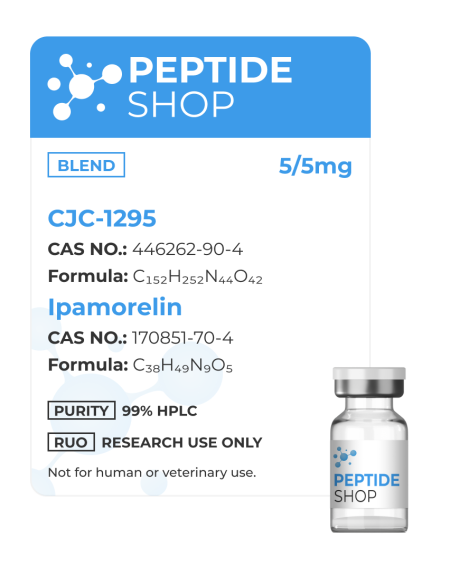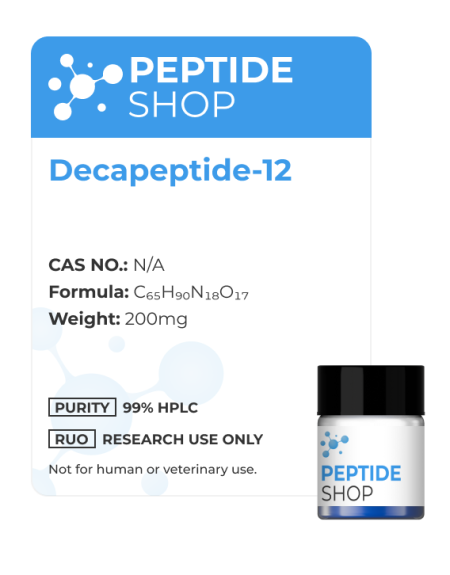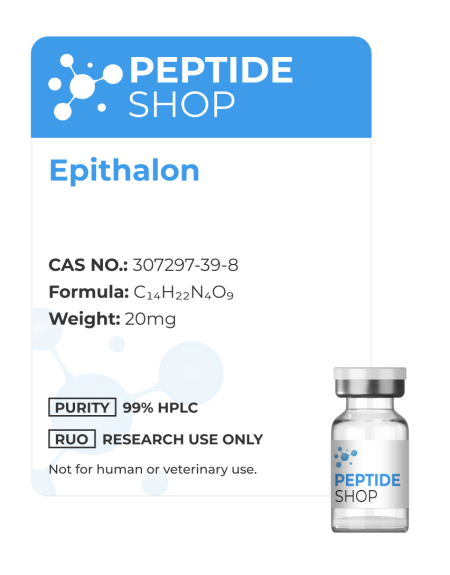-
CJC-1295, Ipamorelin $100.00
CJC-1295 and Ipamorelin peptide are often used in conjunction as their action is synergistic and more than doubly effective. PeptideShop.com offers this blend in a total quantity of 10mg (5mg each).
CJC-1295 Peptide
CJC-1295 is a synthetic hormone-releasing hormone analogue and growth hormone secretagogue. It was developed by ConjuChem Biotechnologies as a means to promote regulation and pulsatile GH secretion. GH therapy is an FDA approved way of treating its deficiencies, diseases such as Turner or Prader-Willi syndrome, idiopathic short stature etc.
The only problem with this approach to treatment is it might be problematic to determine the effectiveness of these therapies due to lacks of biological serum markers. CJC-1295 peptide was developed to mitigate these problems and uncover a more potent and measurable way of secreting GH without affecting its pulsatile nature.
Ipamorelin Peptide
Ipamorelin is also a growth hormone secretagogue, but it also acts as a ghrelin hormone secretagogue receptor agonist, as demonstrated in both in vitro and in vivo studies. Even though its effect is similar to that of CJC-1295, the interesting thing about Ipamorelin is that it does not raise ACTH (Adrenocorticotropic hormone), or cortisol levels for that matter, making it the first GHTP receptor agonist with selective GH release ability.
CJC-1295 And Ipamorelin Peptide Blend
Rather than administering one peptide or the other, more and more research is aimed at testing out the synergistic effect of these two peptides. Some studies showed a 3 or even 5 fold increase in growth hormone secretion increase!
Both CJC-1295 and Ipamorelin will stimulate the pituitary gland to increase GH production and release more hormones through the bloodstream. Animal studies also demonstrated significant ghrelin stimulation, resulting in food intake, fat deposition and muscle building control.
Despite seeing these beneficial results in both GH secretion and appetite regulation, this therapy is still not an FDA approved treatment, as most of our data comes from animal studies. Definitive human studies are needed before moving into the realm of human consumption.
References:
-
Decapeptide-12 200mg $240.00
Size: 200mg
Contents: Decapeptide-12
Form: Lyophilized powder
Purity: >99% -
-
-
Epithalon 20mg/50mg $90.00 – $200.00
Epitalon is a synthetic peptide, made up of 4 amino acids – alanine, glycine, glutamic and aspartic acid. It’s based on a natural peptide epithalamion, commonly extracted from the pineal gland. Some earlier studies showed epitalon’s antioxidant potential, so more recent ones started focusing on its anti-aging potential.
Recent studies also showed its potential in regulating DNA changes, treating infectious diseases… even addressing some types of cancer.
Anti Aging Properties
The fact that epitalon is epithalamin’s extract, means it has the ability to eliminate free radicals that cause tissue damage. A particular research study on flies and mice showed that, after epitalon’s administration, fruit flies mortality rate dropped by a whopping 52%, while the mortality rate in rats dropped by 27%, as compared to the control studies. What researchers learned from this study was that regular epitalon administration stimulated the synthesis and secretion of melatonin, which inhibits free radical production and its subsequent damage.
There was another in vitro study on human somatic non-reproductive cells suggesting that epitalon peptide affects telomerase activity. Telomerase is an enzyme present in cells, allowing them to live longer. So, essentially, this study showed the researchers that this therapy leads to the prolonged cell lifespan. Of course, we still need full scale human studies to see the full extent of prolonged cell lifespan.
DNA Effects
Epitalon also interacts with DNA gene expression, allowing it to have an indirect effect on a whole host of potential bodily functions – from immune system, to skin, tendon and connective tissue repair.
This essentially allows epitalon peptide therapy to have a dual potential effect – on the one hand, it strengthens the immune system and protects the body from outside factors, and on the other, it allows the body to repair and regenerate its structures on its own.
Skin Cell Regeneration
We already talked about epitalon’s effect on DNA and genes. This effect extends to the fibroblast producing and maintaining MMP2. Interestingly, this peptide also affects other skin components, such as collagen and elastin.
Of course, we still have yet to see definitive human studies, but animal ones showed promising results. Young and old rats exposed to epitalon showed skin fibroblast proliferation of 29 and up to 45%. Not only that, epitalon also activates enzymes that slow down programmed cell death.
References:
Yue X, Liu SL, Guo JN, Meng TG, Zhang XR, Li HX, Song CY, Wang ZB, Schatten H, Sun QY, Guo XP. Epitalon protects against post-ovulatory aging-related damage of mouse oocytes in vitro. Aging (Albany NY). 2022 Apr 12;14(7):3191-3202. doi: 10.18632/aging.204007. Epub 2022 Apr 12. PMID: 35413689; PMCID: PMC9037278.
Anisimov VN, Mylnikov SV, Khavinson VK. Pineal peptide preparation epithalamin increases the lifespan of fruit flies, mice and rats. Mech Ageing Dev. 1998 Jun 15;103(2):123-32. doi: 10.1016/s0047-6374(98)00034-7. PMID: 9701766.
Khavinson VKh, Bondarev IE, Butyugov AA. Epithalon peptide induces telomerase activity and telomere elongation in human somatic cells. Bull Exp Biol Med. 2003 Jun;135(6):590-2. doi: 10.1023/a:1025493705728. PMID: 12937682.
-
-
-
-
-
-
-
hGH Fragment 176-191 $80.00
Numerous studies have shown that this peptide may represent numerous opportunities for competent scientists to investigate, especially cartilage regeneration and fatty tissue mitigation.
What is Fragment 176-191 peptide?
This synthetic amino acid sequence mimics the hGH sequence, starting from position 177 to position 191.
AOD 9604, or “lipolytic extract,” is another name for Fragment 176-191. Many researchers argue that Fragment 177-191 may be an important research compound in the context of obesity. They believe it can potentially burn fat in animal models in laboratory settings.
Despite positive results, Fragment 176-191 hasn’t been used for human research purposes and doesn’t have official medical approvals.
Growth hormone
According to research, it appears that hGH Fragment 176-191 may not produce any side effects often related to hGH supplementation. Several adverse effects, such as, impaired glucose tolerance, insulin resistance, and increases in IGF-a levels, have cast doubt on hGH’s use as an obesity treatment. However, when it comes to hGH Fragment 176-191, it doesn’t seem to be impacting blood IGF-1 levels or negatively affecting carbohydrate metabolism.
A trial conducted on Zucker rats in 2000 showed no detrimental effects on insulin sensitivity. Also, an investigation on obese mice done in 2001 did not seem to affect insulin secretion.
Properties
Studies conducted on animals suggest that this peptide can exhibit significant theoretical properties, which will be outlined below:
- The main potential of this Fragment is its lipolytic properties or, in other words, fat-reducing potential. While growth hormones promote development in infancy, they have also been speculated to have an important purpose in maturity.
- Lipoprotein lipase inhibitors may be activated in fat cells,
- By stimulating lipolysis in adipocytes may lead to a decrease in fat cell bulk,
- It might lead to loss of fat from the host body,
Weight
A 14-day trial researching overweight mice came to a conclusion that Fragment 176-191 may have increased skeletal muscle thermogenesis and boosted fat burning.
The study results indicated that this peptide may have enhanced beta (3)-AR RNA (ADRB3) levels, which caused rapid weight reduction in overweight animals but didn’t have much effect on lean mice.
Cartilage
Based on other animal research, it appears that hGH Fragment 176-191 may boost the effects of hyaluronic acid (HA). When Fragment 176-191 was combined with hyaluronic acid, it might boost cartilage formation in white rabbits which have issues with osteoporosis.
References:
Habibullah MM, Mohan S, Syed NK, Makeen HA, Jamal QMS, Alothaid H, Bantun F, Alhazmi A, Hakamy A, Kaabi YA, Samlan G, Lohani M, Thangavel N, Al-Kasim MA. Human Growth Hormone Fragment 176-191 Peptide Enhances the Toxicity of Doxorubicin-Loaded Chitosan Nanoparticles Against MCF-7 Breast Cancer Cells. Drug Des Devel Ther. 2022 Jun 27;16:1963-1974. doi: 10.2147/DDDT.S367586. PMID: 35783198; PMCID: PMC9249349.
https://www.sciencedirect.com/science/article/abs/pii/0304416582900332
Habibullah, Mahmoud & Mohan, Syam & Syed, Nabeel & Makeen, Hafiz & Jamal, Qazi & Alothaid, Hani & Bantun, Farkad & Hakamy, Ali & Kaabi, Yahia & Samlan, Ghalia & Lohani, Mohtashim & Thangavel, Neelaveni & Al-Kasim, Mohamed. (2022). Human Growth Hormone Fragment 176–191 Peptide Enhances the Toxicity of Doxorubicin-Loaded Chitosan Nanoparticles Against MCF-7 Breast Cancer Cells. Drug Design, Development and Therapy. 16. 1963. 10.2147/DDDT.S367586.
-
-
Kisspeptin 5mg/10mg $60.00 – $110.00
Size: 5mg / 10mg
Contents: Kisspeptin
Form: Lyophilized powder
Purity: >99% -
[rev_slider_vc alias="slider-02-1"]
Browse Categories
- Home
- Peptides
- Adipotide (FTPP)
- AICAR
- AOD9604
- BPC-157
- Cagrilintide
- Cerebrolysin
- Gonadorelin
- KPV
- Semaglutide
- Retatrutide
- CJC-1295
- CJC-1295 DAC
- Epithalon
- Ganirelix
- hGH Fragment 176-191
- Ipamorelin
- IGF-1 LR3
- Kisspeptin
- Liraglutide
- TB-500
- Sermorelin
- PT-141
- Oxytocin
- NAD+
- Semax
- Tesamorelin
- Teriparatide
- Thymosin Alpha-1
- Thymalin
- Triptorelin
- Vesugen (Bioregulator)
- Peptide Blends
- Cosmetic Peptides
- FAQ
- Blog
- Contact Us

 Anti Aging
Anti Aging Hair Growth
Hair Growth Muscle Growth
Muscle Growth Peptide Blends
Peptide Blends Peptide Supplies
Peptide Supplies Peptides
Peptides Skin
Skin Testosterone
Testosterone Weight Loss
Weight Loss


















